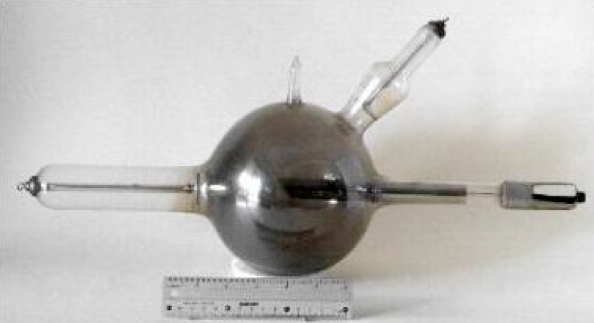The “Platadium” Hydrogen Tube
Ref. B23






This is a 21” (52cms) long and 6” (15cms) strongly discolored bulb. It is made by the “Vacuum Glass Company, Lynn, Mass.” during the first decade of the 20th Century. No Regeneration device.
Although advertised as “having a life more than twice that of the chemical chamber tube”, and “the older the tube, the better it works”, the target embedded in the semi-heavy copper anti-cathode has melted and dripped along the side of the copper support.
It has a vacuum nozzle on top of bulb, a flat aluminum disc anode in a secondary chamber, early dome-shaped electrical end connections and an early type rudimentary metal radiator supporting the anode terminal connection.
“The platinum facing was extremely thin (0.001 inch) and was welded to a disk of nickel, which in turn was soldered to a large mass of copper…….. The tube had a definite energy limitation, and if this were exceeded even for an instant, the thin facing of platinum was ruined at the focal spot, and the tube had outlived its usefulness”.
(Ronald L. Eisenberg, RADIOLOGY, AnIllustrated History, Published by Mosby Year Book, St. Louis, 1992, p.124).
“….With the intense heat caused by the sudden arrest of the electrons forming the cathode stream, plus the mechanical shock of the bombardment, a surface fusion takes place, and the metal is seen to have been heaped up when in a plastic condition around the point of impact”.
(E.R.Morton, A Text-Book of Radiology, Henry Kimpton Ed., 1918, p.47)